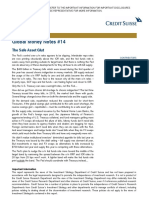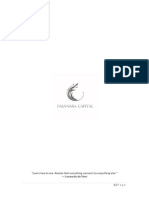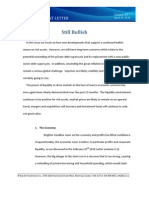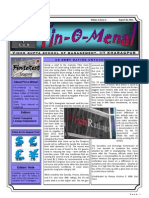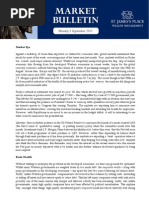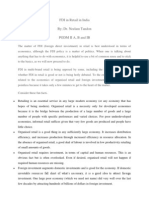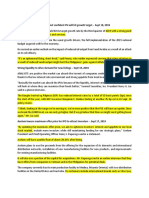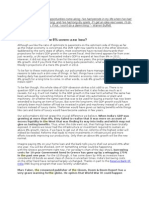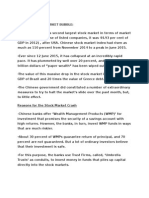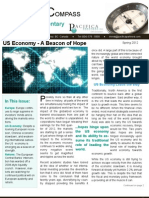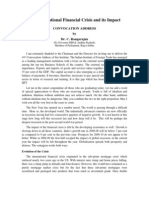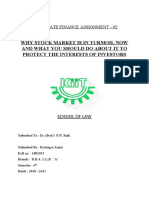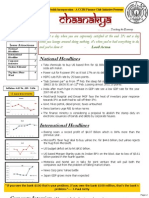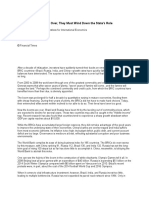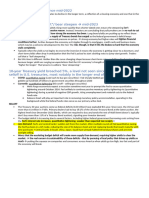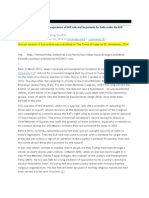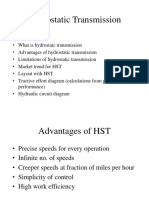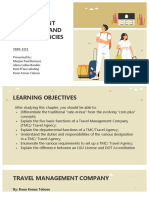Commodities Current Rally Is Likely To Be Limited Business Standard March 23, 2016
Commodities Current Rally Is Likely To Be Limited Business Standard March 23, 2016
Uploaded by
Dr Vidya S SharmaCopyright:
Available Formats
Commodities Current Rally Is Likely To Be Limited Business Standard March 23, 2016
Commodities Current Rally Is Likely To Be Limited Business Standard March 23, 2016
Uploaded by
Dr Vidya S SharmaOriginal Description:
Original Title
Copyright
Available Formats
Share this document
Did you find this document useful?
Is this content inappropriate?
Copyright:
Available Formats
Commodities Current Rally Is Likely To Be Limited Business Standard March 23, 2016
Commodities Current Rally Is Likely To Be Limited Business Standard March 23, 2016
Uploaded by
Dr Vidya S SharmaCopyright:
Available Formats
OPINION 11
>
STAY INFORMED THROUGH THE DAY @ WWW.BUSINESS-STANDARD.COM.
Volume XX Number 157
ILLUSTRATION BY BINAY SINHA
MUMBAI | WEDNESDAY, 23 MARCH 2016
Insurance questions
Far-reaching changes afoot in a vital sector
t the recent Business Standard Insurance Round Table, the leaders of
the industry signalled that far-reaching changes were afoot in the sector. New foreign direct investment regulations have been notified that
will allow foreigners to buy 49 per cent of insurance companies
through the automatic route; the Foreign Investment Promotion Board has also
cleared several big-ticket investments. The Budget, too, made welcome attempts
to bring in transparency and funding to the sector, in particular through the possibility that public sector general insurance giants would be listed on the stock
exchanges. As this newspaper reports, a plan is afoot to offload up to 10 per cent
equity of state-owned general insurance companies through an initial public offering. These are welcome signs. But, in the midst of this energy, open questions
remain. For example, the government has pushed several social security schemes
on to the insurance sector, and they will need to be very carefully structured to
both maintain fiscal prudence and to avoid destabilising this vital industry.
The Budget announced two schemes. Of these, the National Health
Protection Scheme (NHPS) offers health insurance at a highly subsidised rate. The
NHPS has a capped premium and capped payout of up to ~1 lakh per family, with
~30,000 more for senior citizens. The Budget provision has been raised, from ~595
crore to ~1,500 crore, to protect one-third of Indias population against hospitalisation. The other scheme, the Pradhan Mantri Fasal Bima Yojana (PMFBY),
modifies existing crop insurance schemes. Unfortunately, crop claims will still be
triggered on every holding in a region, a problem in past schemes that has not been
remedied. The Centre and respective states will subsidise PMFBY equally, picking up almost all the premium. The premiums will range from two per cent for
kharif crops, 1.5 per cent for rabi crops and five per cent for commercial crops. The
earlier Modified National Agricultural Insurance Scheme had a premium of
around 2.7 to three per cent for many years; the official documentation claimed
that premium rates should be between 1.5 per cent and three per cent, with
additional premium subsidies for small farmers.
But, while few of the structural holes in the schemes have been addressed,
an ambitious broadening of scope is planned. Only 20 million of Indias 140 million farmers had crop insurance in 2014-15. The value covered was only about 5.5
per cent of crops across about 23 per cent of total area under cultivation. The PMFBY aims to expand insurance cover to 50 per cent of farmers, and half of land under
cultivation by 2018-19. Unlike previous crop insurance schemes, which had
capped liabilities, the PMFBY is uncapped and also covers a far wider range of
adverse events. In effect, the Centre picks up almost half the premium. The
Centre will also bear a large share of claims payouts. The PMFBY Budget provision of ~5,500 crore will help set up systems and subsidise premiums. But it will
not necessarily be enough to cover claims, which could be very large. Last year
for example, 200-odd districts in nine states suffered drought with crop losses estimated at over ~25,000 crore from drought alone. Floods, cyclones, and so on are
also common. Claims could add up to huge amounts. The question is whether the
impact on the general insurance sector has been properly calculated. Social
security schemes must be carefully structured so as to maintain sustainability if
claims skyrocket, as seems possible with the PMBSY. The sector has many other
roles in a market economy it is a vital source of long-term capital, for example.
It must not be hobbled by such an over-emphasis on the social sector that it cannot fulfil its other roles.
On public servants
Out of the woods
yet?
Current rally in commodities & currencies is likely to be limited, as
supply corrections can only partially battle subdued global demand
ommodity prices in global markets have been
rising almost continuously since February.
The CRB index, a widely used index of commodities, shows a 10 per cent escalation since mid-February. Copper,
to take a specific example, is also
up some 10 per cent in this period.
Currencies and stock markets of
major commodity producers like
Russia, Brazil and Indonesia have
recovered sharply. The bets that
crude oil would touch 20 or even 10
dollars a barrel seem to be off the
table at least for now.
This particular rally in com- ABHEEK BARUA
modity prices is what one might
call a risk-on anti-dollar rally. The
dollar has fallen not just against
commodity-linked assets but against other asset
prices as well. Emerging market currencies like the
rupee that are not directly linked have also gained,
as investors have started to take more risks and
climb out of the safe haven of the dollar and dollar
assets like treasuries.
The obvious question then is: will this rally last?
Some argue that since nothing much has happened
to demand (there arent any signs that growth in the
major commodity guzzlers like China is picking up),
this is just a case of dumb money chasing a bubble.
And yes, theres cheap money sloshing around courtesy the European Central Banks decision to print
more euros and cut their already negative interest
rates further on bank deposits with
the central bank. The Bank of Japan
is likely to start printing more yen to
unleash a round of quantitative easing and the US Fed seems unsure of
whether it is in a position to raise
rates. Whether this embarrassment
of liquidity is fueling dumb trades is
the critical issue.
There is an alternative view. This
points to the fact that supply of
major commodities is reducing
sharply. Take copper again.
Producers who had been holding
on to output for much of 2015 in the
hope of better prices have started paring production from late 2016. Miners including London-listed
Glencore, US-based Freeport and Polands KGHM
have already reduced production. With 50 per cent
of the miners around the world running operating
losses, more supply cuts seem likely. This is happening with other commodities as well. This moderation is likely to set a floor to commodity prices this
year even if the rally loses momentum. So 2016 could
set a base and could see the beginning of a secular
rise in commodity prices.
Let me go with this view and explore the implications. If commodity prices do rise, it might arrest
the deflationary trend that has bogged down
economies across the world. Central bankers who
have trying to battle this deflation with every trick in
their books (from overworking their money-printing
machines for quantitative easing to offering negative
interests for excess cash that banks want to hold
with them) can breathe a sigh of relief. If the rise and
stability in prices continues to take the sting out of
the dollars appreciation, it might mean more flows
into other markets including India.
Commodity producers whose balance sheets
and P&Ls have been battered over the last couple of
years have also contributed the bulk of non-performing loans not just in India (where steel producers for instance contribute a hefty fraction of bad
debt) but in other countries like China. They might
see the first signs of revival and ease the pressure on
the banking system.
That said, this rise in prices is could turn out to be
a mixed blessing. The anti-dollar trade is the flipside
of the commodity run. Thats suddenly led to a surge
in portfolio flows and appreciation in non-dollar
currencies. The rupee is suddenly looking a trifle
overvalued and the RBI has been buying dollars
aggressively to thwart this.
Then there is the business of inflation. Higher
commodity prices could mean that we might lose
the little help that we have had for the last couple
of years on the inflation front from softer prices.
This would be particularly problematic if oil prices
start to rise too. Besides, the flood of capital inflows
might mask a creeping rise in imports that would
slowly widen the current account deficit. And so on
and so forth.
The biggest risk in my opinion stems from the
baffling circularity with which markets often think
about things. If global deflation tends to ease, markets will slowly start worrying about the US Federal
Reserve hiking rates. If indeed one goes with the
assumption that the Fed is the pivot around which
markets move, there could be a situation when the
markets start factoring in an imminent US rate hike.
This could lead to a flight of capital from risky assets
like emerging market debt and stocks. India has a
current account deficit to fill and a sudden stop in
capital flows would be far more difficult to handle
than a surge of inflows.
My prognosis is that the current rally in commodities and currencies is likely to be limited. Global
demand is still subdued and while supply corrections can help improve the balance, it cannot take
prices up much further. Besides, all the risks are still
on the table another mini-crisis in Europe, the
prospect of Britain leaving the EU, further bad news
from China (particularly from its financial sector),
and the prospect of the Fed hiking rates. Yes, the
stock market here could climb a little higher and
the rupee could rise a little more. However, the second half of the year could tell a different story.
The writer is chief economist, HDFC Bank
Implications of Supreme Courts ruling for private businesses
ecently, the Supreme Court ruled that senior employees of private
sector banks would be considered public servants when it came
to deploying the provisions of the Prevention of Corruption Act of
1988, or PC Act. The Court said that the intent of Parliament when
enacting the PC Act was to widen the notion of a public servant. It indicated that the guiding legislation for the sector, the Banking Regulation Act of
1949, said senior bankers were public officials; this was relevant, when
drafted, to provisions of the Indian Penal Code that were subsequently superseded by the PC Act. The Court held in its main judgment that the appropriate parts of the Banking Regulation Act could not be left meaningless, and
that this was an unintended omission by the legislative branch which the
judicial branch would have to cause to be filled up. A concurrent opinion
from the bench held that a public servant for the purposes of the PC Act was
anyone discharging duties in which the state, the public or the community
at large has an interest.
The implications for the banking sector and beyond are considerable, and
will worry many. Certainly, many have pointed out that public sector bankers
have to worry about the PC Act, so why should not their counterparts in the
private sector? This misses the point. In fact, it is employees of public sector
corporations who should be made exempt from corruption legislation
designed to control state employees. If public sector corporations are to be
imagined as professional and competitive, they should be subject to the same
legal regime as the private sector; their public purpose should be defined by
the state-appointed representatives on their boards, and not by the legal
regime they are subject to. In addition, defining public servant as those conducting any duties in which the state, the public or the community at large
has an interest may lead to too broad an expansion when implemented by
the executive branch. Can it now be argued that, given state and public interest, private insurers should next be investigated under the PC Act?
The Supreme Court has the final word, constitutionally, on interpreting
the intent behind existing legislation. However, an amendment to the PC Act
is planned to be passed by Parliament. This amendment, which contains
much progressive reform of the statute, should be urgently reviewed in the
light of this new development. Parliament must debate exactly which jobs constitute public service, and whether private bankers and others or even public sector employees should be subject to the PC Act. If necessary, the
Banking Regulation Act should also be amended in the light of this debate. The
intent of the legislature should be made clear.
Diagnosing our ailing cities
n urban crisis is upon us Delhis air pollution,
Chennais floods, Bengalurus garbage. This is
not something unknown or unanticipated,
merely the culmination of a long process. A study by
Janaagraha, a Bengaluru-based non-government
organisation focused on improving the quality of life
in urban India, has found that urban
issues prominent in public discourse
have not changed in 30 years.
Adopting a drastic cure cannot
be postponed any longer. This needs
diagnostic tests that yield rich data.
Janaagraha has released its third
Annual Survey of Indias CitySystems (ASICS 2015) which is now a
source of comparable data over a
period of time that gives experts a
chance to get to the roots of the
malaise. The depressing overview,
according to Janaagrahas founder
and leader, Ramesh Ramanathan, is SUBIR ROY
that over the three-year period little
has changed. The scores of leading
Indian cities under the chosen parameters remain at
about the same low levels.
Popular discourse on Indias urban malaise is usually focused on symptoms but it is the disease that
needs to be treated, observes Srikanth Viswanathan
who has led the ASICS research. There is a common set
of root causes for the poor quality of urban life. These
have been brought under a city-systems framework
that has four interconnected components: planning
and design; capacities and resources; empowerment
and political representation; and transparency,
accountability and participation. If you adopt this
approach, you address systemic issues which hold our
cities back.
Ultimately, it is not resources which hold back the 21
cities in 18 states including all the state capitals that
ASICS covers, but governance. A reform agenda is needed to fix the vacuum in local governance. The centre and
the states have to cooperate to empower urban local
VALUE FOR MONEY
The bitter fight over sugary drinks
BOOK REVIEW
UTTARAN DAS GUPTA
Last month, Coca-Cola suspended bottling operations at three plants in India,
including in Rajasthan. This plant has
been in the eye of protests by local
farmers, who complained that the company was using depleting ground water
reserves in the parched north-western
state. Hindustan Coca-Cola Beverages,
a subsidiary of The Coca-Cola Co, however, has claimed that it was a responsible corporate citizen, harvesting rainwater and encouraging farmers to use
drip irrigation, which is a more efficient
method of watering crops than tradi-
tional alternatives.
While the debate over corporate
ethics will continue, the countrys
~14,000-crore soft drinks industry is facing other challenges. In the Budget for
2016-17, the Union government raised
excise duty on soft drinks to 21 per cent
from 18 per cent. This is the second year
that the sector has faced a levy increase
and, this time it will affect the price by
one to two per cent, in turn hitting sales.
Coca-Cola and PepsiCo, the countrys
two major soft drink producers, are
already reeling from single-digit volume
growth, with more and more customers
moving to healthier drinks.
In this context, Marion Nestles new
book on how to fight the behemoth that
is the soft drink industry and achieving
that feat of registering a win for good
health advocates is timely. The Paulette
Goddard Professor of Nutrition, Food
Studies and Public Health at the New
York University, Ms Nestle has been at
bodies so that they can deliver, be accountable and
transparent. But politicians are by nature statusquoists
who will not voluntarily give up power. How the tipping
point will come to enable change is the cardinal conundrum hanging over non-functional city systems.
ASICS 2015 reveals that most cities cannot implement their spatial development plans.
Even when there are plans they do
not synchronise, as in the case with
the plans for the local bodies coming
under the Mumbai metropolitan
area. In Bengaluru the boundaries of
various bodies that deliver water,
power and transport do not coincide. Ergo, confusion.
Absolutely no city has an effective mechanism to deter planning
violations. In Delhi, over 30 per cent
of the population lives in unauthorised colonies. This is after over
2,200 of them have been regularised.
Since 1947 over 3,000 colonies have
been authorised.
Most cities severely lack the ability to raise their own
resources. Payment of salaries and wages leaves little
for capital expenditure, thus making cities dependent on central and state governments. It is rich cities
like Mumbai and Delhi and a relatively well-run city
like Pune that mostly make the cut.
The material resource shortage has a companion in
the shortage of human skills. Adequate manpower
with the right skills, and stability of leadership, are
critical issues. There are close to 8,000 census towns
but only 5,000 town planners in the country. The average tenure of municipal commissioners varies widely,
from under one year for Raipur to over four years for
Ahmedabad.
How well material and human resources are used
and what kind of leadership a city has is reflected in its
use of information technology. Cities like Bhopal, Delhi,
Mumbai, Pune and Surat (again a shortlist of cities
with somewhat, only somewhat, better systems) score
the forefront of the fight for food choice,
healthy living and against obesity in the
US since before publishing her breakout
book, Food Politics (2002). Now, she
focuses her attention on the despicable
marketing practices soft drink companies employ to expand sales and profit
at the cost of global health.
At the start of her book, Ms Nestle
writes about her fascination with soft
drinks, or sodas: Sodas are astonishing
products. Little more than flavoured sugar water, these drinks cost practically
nothing to produce or buy, yet have
turned their makers principally CocaCola and PepsiCo into multibillion-dollar industries with global recognition,
distribution, and political power. She
also writes about why advocacy against
soft drinks is necessary: An occasional
sugary drink is hardly a health concern.
But many Americans especially those
who are young, members of minority
groups, and poor habitually drink large
volumes of soda on a daily basis at great
harm to their health.
Soft drink companies, Ms Nestle
demonstrates in her book, target these
vulnerable groups. In the chapter
Starting Early: Marketing to Infants,
Children, and Teens, she links the
habit of TV watching and soft drink
consumption by children: Soda drinking is so closely linked to watching television that its consumption can be predicted by formula: the probability that
children will consume sodas up to three
times per week rises 50 per cent for
every hour a day they watch television,
and by 60 per cent if they are watching
commercials.
Like everything else in this wonderfully erudite book, this information has
been sourced from a scholarly study
one that goes on to claim: Nine out of
10 food advertisements shown during
Saturday morning childrens television
programming are for foods high in fat,
sodium, or added sugars, or low in
nutrients. But this book is also about
the solutions, which, for Ms Nestle, lies
in advocacy. In subsequent chapters,
the best. An outlier is Chennai which has an overall
poor score but has made progress by installing an
enterprise IT system from 2009. Online assessment of
property tax and collection, running the workforce
with greater efficiency, approving building plans and
tracking complaints have all entered a new era.
If there is any one issue which matters then it is
empowerment, particularly the role and status of the
mayor. Right at the top are cities with directly elected
mayors with five-year terms. Eight out of the 21 cities
surveyed (Bhopal, Chennai, Dehradun, Jaipur, Kanpur,
Lucknow, Raipur and Ranchi make the cut.) On the
other hand Ahmedabad and Bengaluru get one-year
mayors and Mumbai a new one every 2.5 years. Most
unfortunately not a single mayor has the right to
appoint the municipal commissioner. To enable
empowerment, a key reform is ensuring devolution of
all the 18 functions listed in the 74th Amendment to the
Constitution.
One of the most useful sets of data in the survey
comes under the rubric of transparency, accountability and participation. This addresses issues like: does
it mandate disclosure of audited financial statements,
details of plans, income and budgets? Are internal
audits of urban local bodies available in the public
domain? Are there open data standards for financial
information (budgets) and annual report on works?
Cities which fare well are Hyderabad, Bengaluru, Pune
and Mumbai.
Reforms do happen and one example is Odisha
which has taken steps to create a dedicated, exclusive
municipal cadre for administrators. This seeks to
address the paucity of experts in domains like urban
planning and transportation which are making do by
relying on the open market, consultancies and outsourcing. Empowered urban local bodies with powerful democratically elected mayors for respectable
terms, aided by officials who have a career stake in local
government, offer the foundations on which a viable
urban India can be built.
subirkroy@gmail.com
she outlines tried and tested tactics
used by public health advocates and
campaigners in the US and can be
adopted by their counterparts in the
other countries.
The breadth of the books ambition
is evident in Ms Nestle incorporating
voices from within the soft drink industry into conversations about how to promote healthy living. In the course of
committed advocacy, it is often easier to
aim ones attacks at the monoliths of
corporate structures, but it is more difficult to deal with individuals. One of the
most interesting individuals in Soda
Politics is Dr Derek Yach, a South
African health professional who supervised a 2003 consultation report for the
World Health Organization (WHO)
aimed at establishing a research basis
for a global strategy to reduce obesity.
As expected, he ran into trouble with
big soda and was forced to quit his job
as director of non-communicable diseases at the WHO, even as his report
was being published.
Then, in 2007, he joined PepsiCo as
the vice-president of global health poli-
cy. Next year, he published an editorial
in British journal Public Health
Nutrition explaining the move, and
PepsiCo Chief Executive Office Indra
Nooyi explained the hiring as: We have
asked Derek to change this company; in
five years we want to have most of our
product line meet the international
standards supporting life-long health.
So how successful was Dr Yach? About
65 per cent, he claims. While he did
manage to steer PepsiCo towards producing healthier alternatives for soft
drinks, with the global recession impacting profits, the company had to focus
more and more on its core products,
even as Dr Yach left for other engagements. This incident illustrates the complexity of the battle and how people
inside and outside the industry must
come together to make it a success.
SODA POLITICS
Taking on Big Soda [and Winning]
Marion Nestle
Oxford University Press
508 pages; ~676
You might also like
- Mckinsey's 7s ZARADocument44 pagesMckinsey's 7s ZARAAtharva Gore100% (3)
- Global Money Notes #14: The Safe Asset GlutDocument16 pagesGlobal Money Notes #14: The Safe Asset GlutPhilippe100% (1)
- Hyundai - Blue Print Tech Article EPS Part1Document4 pagesHyundai - Blue Print Tech Article EPS Part1Ahmed I. EltaherNo ratings yet
- India's Bubble Economy Headed Towards Iceberg?: CategorizedDocument6 pagesIndia's Bubble Economy Headed Towards Iceberg?: CategorizedMonisa AhmadNo ratings yet
- Fasanara Capital Investment Outlook - May 3rd 2016Document17 pagesFasanara Capital Investment Outlook - May 3rd 2016Zerohedge100% (1)
- Investime-Sept22Document27 pagesInvestime-Sept22Prabu kumarNo ratings yet
- Volume 2.4 Still Bullish Apr 13 2010Document12 pagesVolume 2.4 Still Bullish Apr 13 2010Denis OuelletNo ratings yet
- Global Economic Crisis and Indian EconomyDocument11 pagesGlobal Economic Crisis and Indian EconomyabhaybittuNo ratings yet
- Sub Prime LendingDocument4 pagesSub Prime Lendinggagan585No ratings yet
- Quick DollarDocument40 pagesQuick DollarANKIT_XXNo ratings yet
- DR.C Rangarajan - SubprimeDocument12 pagesDR.C Rangarajan - SubprimeRidhimohanNo ratings yet
- Financial Crisis and Its Effect On BanksDocument5 pagesFinancial Crisis and Its Effect On BanksTejo SajjaNo ratings yet
- Vinod Gupta School of Management, IIT KHARAGPUR: About Fin-o-MenalDocument4 pagesVinod Gupta School of Management, IIT KHARAGPUR: About Fin-o-MenalFinterestNo ratings yet
- Burch Wealth Management 05.09.11Document3 pagesBurch Wealth Management 05.09.11admin866No ratings yet
- Crash of Market in ChinaDocument5 pagesCrash of Market in ChinaLalit SinghNo ratings yet
- Good Newspapers ArticlesDocument151 pagesGood Newspapers ArticlesManish YadavNo ratings yet
- Should The RBI Bow Down To Govt. Pressure?: and We Recommend You Watch This Free Video Right Away..Document4 pagesShould The RBI Bow Down To Govt. Pressure?: and We Recommend You Watch This Free Video Right Away..vivekchitale123No ratings yet
- JP Morgan Global Research 8 Dec 2023 2024 Year Ahe 240116 152842Document71 pagesJP Morgan Global Research 8 Dec 2023 2024 Year Ahe 240116 152842ruri tandiansyahNo ratings yet
- Role of Capital Market in IndiaDocument6 pagesRole of Capital Market in Indiajyoti verma100% (1)
- FDI in Retail in India ME and BEDocument5 pagesFDI in Retail in India ME and BERam PandeyNo ratings yet
- The Financial Crisis and The Developing WorldDocument4 pagesThe Financial Crisis and The Developing WorldmustafeezNo ratings yet
- Subprime Crisis and The Impact On IndiaDocument4 pagesSubprime Crisis and The Impact On IndiaManoj M. GolvankarNo ratings yet
- The World Economy - 19/03/2010Document3 pagesThe World Economy - 19/03/2010Rhb InvestNo ratings yet
- Optimism Prevails As Neda Chief Confident PH Will Hit Growth Target - Sept 19, 2019Document8 pagesOptimism Prevails As Neda Chief Confident PH Will Hit Growth Target - Sept 19, 2019Mavic PeñalozaNo ratings yet
- Golden enDocument22 pagesGolden enfcyaoquanNo ratings yet
- 3rd Quarter 2005 CommentaryDocument2 pages3rd Quarter 2005 CommentaryNelson Roberts Investment AdvisorsNo ratings yet
- Running Head: ECONOMICSDocument12 pagesRunning Head: ECONOMICSRajshekhar BoseNo ratings yet
- ILL THE Curse OF Below Growth Leave Ndia: Reserve Bank of IndiaDocument12 pagesILL THE Curse OF Below Growth Leave Ndia: Reserve Bank of IndiaVinayraj TenkaleNo ratings yet
- BricDocument3 pagesBricManhao TangNo ratings yet
- China's Stock Market BubbleDocument6 pagesChina's Stock Market BubbleVinit ShahNo ratings yet
- Banking Crises Are Usually Followed by Low Credit and GDP GrowthDocument4 pagesBanking Crises Are Usually Followed by Low Credit and GDP GrowthKiran MahaNo ratings yet
- Investment: Buffett: Buying Bonds Here Is A MistakeDocument21 pagesInvestment: Buffett: Buying Bonds Here Is A MistakeVivekNo ratings yet
- Impact of U.S. Fed Rate Hike On Indian EconomyDocument5 pagesImpact of U.S. Fed Rate Hike On Indian EconomyT ForsythNo ratings yet
- Global Economic Slowdown Impacting Consumer DemandDocument7 pagesGlobal Economic Slowdown Impacting Consumer Demandmadcow0070No ratings yet
- Nvestment Ompass: Quarterly CommentaryDocument4 pagesNvestment Ompass: Quarterly CommentaryPacifica Partners Capital ManagementNo ratings yet
- Security Analysis and Portfolio ManagementDocument21 pagesSecurity Analysis and Portfolio ManagementAkshay SharmaNo ratings yet
- Byron Wein - Blackstone - Time For A PauseDocument4 pagesByron Wein - Blackstone - Time For A PausewaterhousebNo ratings yet
- Impact of The Global Financial Crisis by D SubburaoDocument6 pagesImpact of The Global Financial Crisis by D SubburaoDhruv VatsNo ratings yet
- Impact of Global Financial Crisis On PakistanDocument16 pagesImpact of Global Financial Crisis On Pakistannaumanayubi93% (15)
- The International Financial Crisis and Its Impact: Convocation Address by Dr. C. RangarajanDocument5 pagesThe International Financial Crisis and Its Impact: Convocation Address by Dr. C. RangarajanAnand SoniNo ratings yet
- Presented by Piyush Chawala Sukant Prusty Anurag Nath Satish Naik Manjushaa Hemanth KumarDocument63 pagesPresented by Piyush Chawala Sukant Prusty Anurag Nath Satish Naik Manjushaa Hemanth Kumarsalonid17No ratings yet
- Kushagra Amrit 1882053Document10 pagesKushagra Amrit 1882053Kushagra AmritNo ratings yet
- Global and Local Market Outlook v5Document11 pagesGlobal and Local Market Outlook v5ShinThant LinnNo ratings yet
- 2015: Outlook for Stocks, Bonds, Commodities, Currencies and Real EstateFrom Everand2015: Outlook for Stocks, Bonds, Commodities, Currencies and Real EstateNo ratings yet
- The Consequences Are ProfoundDocument3 pagesThe Consequences Are ProfoundshamikbhoseNo ratings yet
- Coronavirus and Its Impact On Global Financial MarketsDocument3 pagesCoronavirus and Its Impact On Global Financial MarketsAnkur ShardaNo ratings yet
- 12 - 16th February 2008 (160208)Document5 pages12 - 16th February 2008 (160208)Chaanakya_cuimNo ratings yet
- A Time For Caution in Global Markets?Document3 pagesA Time For Caution in Global Markets?tera.secret santaNo ratings yet
- Now The Brics Party Is Over, They Must Wind Down The State'S RoleDocument4 pagesNow The Brics Party Is Over, They Must Wind Down The State'S RoleGma BvbNo ratings yet
- International Monetary Fund: Recession Is More Difficult, Because Developing Nations Are Expected To Have A HigherDocument5 pagesInternational Monetary Fund: Recession Is More Difficult, Because Developing Nations Are Expected To Have A Highersatyajit_63No ratings yet
- CurrenciesDocument6 pagesCurrenciesShujath SharieffNo ratings yet
- The Growing Opportunity For Investment Banks in Emerging MarketsDocument8 pagesThe Growing Opportunity For Investment Banks in Emerging Marketsrjsnayoan6997No ratings yet
- Global 4Document89 pagesGlobal 4MiltonThitswaloNo ratings yet
- Safiullah Sir AssDocument6 pagesSafiullah Sir AssAvijit SahaNo ratings yet
- IMT Covid19Document6 pagesIMT Covid19Cosmos starNo ratings yet
- Fourth Q Uarter R Eport 2010Document16 pagesFourth Q Uarter R Eport 2010richardck61No ratings yet
- Effect of Euro Debt Crisis On IndiaDocument2 pagesEffect of Euro Debt Crisis On IndiaBrajesh PandeyNo ratings yet
- US 2 NovDocument6 pagesUS 2 NovC QNo ratings yet
- Rate Rises As Hopes For Easing Uk Social Distancing Rules Grow 48118Document4 pagesRate Rises As Hopes For Easing Uk Social Distancing Rules Grow 48118Pratik ChourasiaNo ratings yet
- Global Weekly Economic Update - Deloitte InsightsDocument34 pagesGlobal Weekly Economic Update - Deloitte InsightsGANGULYABHILASHANo ratings yet
- Follow the Money: Fed Largesse, Inflation, and Moon Shots in Financial MarketsFrom EverandFollow the Money: Fed Largesse, Inflation, and Moon Shots in Financial MarketsNo ratings yet
- Australia Copes With A Hung Parliament Hindu Business Line 15092010Document1 pageAustralia Copes With A Hung Parliament Hindu Business Line 15092010Dr Vidya S SharmaNo ratings yet
- Abe Shintaro Makes An Exit EUReporter September 09, 2020Document8 pagesAbe Shintaro Makes An Exit EUReporter September 09, 2020Dr Vidya S SharmaNo ratings yet
- Water Management Business Standard, March 22, 2016Document1 pageWater Management Business Standard, March 22, 2016Dr Vidya S SharmaNo ratings yet
- Erdogan and Modi Amitav Ghosh 241114Document12 pagesErdogan and Modi Amitav Ghosh 241114Dr Vidya S SharmaNo ratings yet
- Anatomy of Aswachh Bharat Business Standard December 17, 2014Document1 pageAnatomy of Aswachh Bharat Business Standard December 17, 2014Dr Vidya S SharmaNo ratings yet
- Bangalore's Impending Water Crisis Deccan Herald 02 January, 2011Document1 pageBangalore's Impending Water Crisis Deccan Herald 02 January, 2011Dr Vidya S SharmaNo ratings yet
- Senator Brandis Is Wrong On Sharia Law 090412Document2 pagesSenator Brandis Is Wrong On Sharia Law 090412Dr Vidya S SharmaNo ratings yet
- PML-N Swears by Anti-Terror Policy Deccan Herald (India), May 13, 2013Document1 pagePML-N Swears by Anti-Terror Policy Deccan Herald (India), May 13, 2013Dr Vidya S SharmaNo ratings yet
- Papal Politics, Paul VI, and Vatican II: The Reassertion of Papal Absolutism by Aaron MilavecDocument13 pagesPapal Politics, Paul VI, and Vatican II: The Reassertion of Papal Absolutism by Aaron MilavecDr Vidya S SharmaNo ratings yet
- Advani Stokes Jinnah Fire Part 1 Thwe Hindustan Times: February 14, 2011Document1 pageAdvani Stokes Jinnah Fire Part 1 Thwe Hindustan Times: February 14, 2011Dr Vidya S SharmaNo ratings yet
- Afghan Mine Bid and Indian Consortium Mint 24 August, 2011Document1 pageAfghan Mine Bid and Indian Consortium Mint 24 August, 2011Dr Vidya S SharmaNo ratings yet
- American Eagle, Afghan Cage The Indian Express 28 April, 2011Document1 pageAmerican Eagle, Afghan Cage The Indian Express 28 April, 2011Dr Vidya S SharmaNo ratings yet
- American Muslims Ask Will They Ever Belong Deccan Herald September 08, 2010Document1 pageAmerican Muslims Ask Will They Ever Belong Deccan Herald September 08, 2010Dr Vidya S SharmaNo ratings yet
- Management Acct AssignmentDocument11 pagesManagement Acct AssignmentYasir ArafatNo ratings yet
- DWM Unit 1. Introduction To Data WarehousingDocument12 pagesDWM Unit 1. Introduction To Data Warehousingjemsbonnd100% (4)
- 6-Sinf WB 3-ChorakDocument28 pages6-Sinf WB 3-ChorakPekin Bolalar kiyimlari.No ratings yet
- Report Warehouse ManagementDocument37 pagesReport Warehouse ManagementChau AnhNo ratings yet
- Imię I Nazwisko: - KlasaDocument1 pageImię I Nazwisko: - KlasaPatrycjaxddNo ratings yet
- HST TrainingDocument11 pagesHST TrainingRamesh BabuNo ratings yet
- 08.phil. Long Distance Telephone Co. vs. NLRCDocument13 pages08.phil. Long Distance Telephone Co. vs. NLRCCharisseCastilloNo ratings yet
- Entrance Exam Question PaperDocument4 pagesEntrance Exam Question PaperJanhvi Kishori ThakkarNo ratings yet
- Dr. Rakesh Kumar Tiwari Faculty of Social Science Mahatma Gandhi Kashi Vidyapith Varanasi-02Document27 pagesDr. Rakesh Kumar Tiwari Faculty of Social Science Mahatma Gandhi Kashi Vidyapith Varanasi-02harshithaNo ratings yet
- Netbackup 8.0 Blueprint OpsCenterDocument59 pagesNetbackup 8.0 Blueprint OpsCenteralireza1023No ratings yet
- Tutorial React NativeDocument117 pagesTutorial React NativeguterioNo ratings yet
- Temporary Partial Denture 3rd Year 22-3-2020Document57 pagesTemporary Partial Denture 3rd Year 22-3-2020Kareem ShehataNo ratings yet
- Philippines As A Megadiverse CountryDocument3 pagesPhilippines As A Megadiverse CountryMikaela Francesca RazonNo ratings yet
- Risk Mitigation PlanDocument3 pagesRisk Mitigation Plansuryakrish krishnanNo ratings yet
- Market Leader Progress TestDocument3 pagesMarket Leader Progress TestBenGreenNo ratings yet
- World Is Flat Thomas FriedmanDocument10 pagesWorld Is Flat Thomas FriedmanGilean DalidaNo ratings yet
- The Iron Warrior: Volume 28, Issue 8Document16 pagesThe Iron Warrior: Volume 28, Issue 8The Iron WarriorNo ratings yet
- Travel Agency ManagementDocument47 pagesTravel Agency ManagementKatherine BarretoNo ratings yet
- Kenny-230718-Top 60+ Data Analyst Interview Questions and Answers For 2023Document39 pagesKenny-230718-Top 60+ Data Analyst Interview Questions and Answers For 2023vanjchaoNo ratings yet
- PWC-S04-SS03-Fuel Tank and Fuel Pump - Shop Manual - 4-TEC - Version 2AA - ENDocument24 pagesPWC-S04-SS03-Fuel Tank and Fuel Pump - Shop Manual - 4-TEC - Version 2AA - ENAlexander AbregoNo ratings yet
- Vinculum Vmusic1 Schematic: Headphone JackDocument1 pageVinculum Vmusic1 Schematic: Headphone JackAndersonNo ratings yet
- 1 Griar - Counterclaim - Blay vs. BanaDocument2 pages1 Griar - Counterclaim - Blay vs. BanaStephanie GriarNo ratings yet
- BOM CarwashDocument1 pageBOM Carwashjoyce karen cadacioNo ratings yet
- Calc Scripts For Mere MortalsDocument94 pagesCalc Scripts For Mere MortalsparmitchoudhuryNo ratings yet
- CV Europass 20181121 RadmanFunarić HR 21.11.2018.Document10 pagesCV Europass 20181121 RadmanFunarić HR 21.11.2018.Veleučilište u PožegiNo ratings yet
- Saep 12Document42 pagesSaep 12hamzah MajedNo ratings yet
- #Ieltsdori - Vocabulary For Academic IELTS Writing Task 1Document51 pages#Ieltsdori - Vocabulary For Academic IELTS Writing Task 1Quang LinhNo ratings yet
- BOT Tender TMCDocument139 pagesBOT Tender TMCrohit100% (1)

